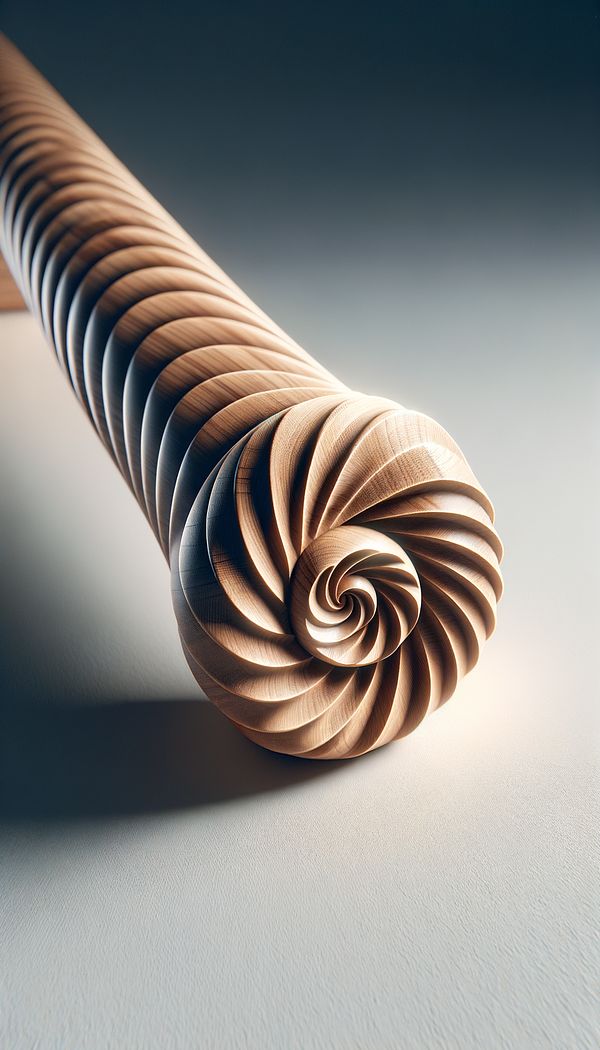What is Spiral Turning?
Spiral Turning is a decorative woodworking technique that creates twisted patterns along the length of a piece of wood.
Description
Spiral Turning refers to the intricate process of shaping wood into a helical form, effectively infusing pieces of furniture or architectural elements with a visually striking twist pattern. This technique, which falls under both the categories of decorative techniques and fabrication and craftsmanship, demands a high level of skill and precision. It is applied to wood through the use of a lathe, a tool that rotates the wood piece as it is cut, allowing for the creation of deep grooves that spiral along its length.
Traditionally, spiral turning has been utilized to embellish items such as table legs, bedposts, and stair banisters, adding a sophisticated and elegant touch. In contemporary interior design, its application stretches beyond mere decoration to include functional elements within spaces, like handrails that are not only aesthetically pleasing but provide a unique tactile experience.
The beauty of spiral turning lies in its versatility and the ability to customize the twist to suit different design styles, from the classical to the modern. The intricacy of the patterns can vary, ranging from tight, intricate spirals to more loose and flowing designs, making each piece unique. Knowing the right tools, techniques, and wood types is crucial in achieving the desired outcome, making this a sought-after skill among woodworkers and interior designers.
Usage
In a traditional Victorian-style home, spiral turning might be used to add historical accuracy and visual interest to the staircase banisters. In a modern setting, a designer might incorporate spiral-turned elements in a minimalist wooden art installation to add texture and depth without overwhelming the space.
FAQs
-
How is spiral turning performed?
Spiral turning is performed using a lathe, which rotates the wood piece as specialized tools are applied to cut into its surface, creating the characteristic helical grooves. The process requires the steady hand and keen eye of an experienced woodworker.
-
Can spiral turning be applied to any type of wood?
While spiral turning can be applied to a variety of wood types, certain species are more favorable due to their grain patterns, workability, and overall stability. Hardwoods such as oak, maple, and walnut are commonly chosen for their superior results in spiral turning.
-
Is spiral turning only used for decorative purposes?
Though primarily used for decoration, spiral turning also has functional applications, such as providing an improved grip on handrails or enhancing the tactile experience of furniture pieces.
-
Can spiral turning be used in modern interior design?
Absolutely. While spiral turning is rooted in traditional craftsmanship, its adaptability allows it to be integrated into modern interior designs. It can add a unique textural element to space, bridging past and present design trends.
-
How does spiral turning influence the value of a piece?
Spiral turning can significantly increase the value of a piece due to the skill and time involved in creating it. The uniqueness and craftsmanship of spiral-turned items make them highly sought after in both the antiques market and in contemporary design.
Practical Application
For those interested in incorporating spiral turning into their designs, consider starting with a single, focus piece such as a table or floor lamp. This allows the intricate workmanship to stand out without overwhelming the space. When selecting wood, consider the characteristics that best suit the design intent and the spiral pattern desired. Practice and experimentation are key to mastering this technique, so patience and attention to detail are essential.
-
CarcaseCarcase refers to the framework or body of a piece of furniture, typically hidden beneath the surface materials.
-
Traverse DraperyTraverse drapery refers to a type of curtain designed to be opened and closed by pulling a cord.
-
Ragging OffRagging off is a decorative paint technique that involves creating texture by removing wet glaze or paint with a rag.
-
End MatchingEnd matching refers to a technique used in the installation of wood flooring and paneling.
-
Bonnet TopA decorative top piece on furniture that resembles the shape of a bonnet.
